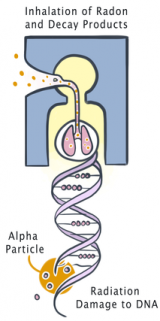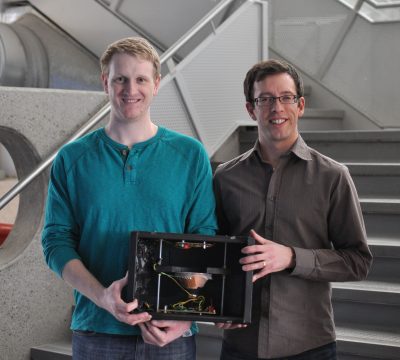 According to Health Canada, an estimated 3,000 Canadians die each year from lung cancer induced by radon exposure. A Carleton team is trying to change that.
According to Health Canada, an estimated 3,000 Canadians die each year from lung cancer induced by radon exposure. A Carleton team is trying to change that.
Graduate engineering Student Alex Ross first heard of radon when he was looking for a focus for his fourth-year engineering project.
Radon is an invisible, odourless and tasteless radioactive gas found naturally in the earth. Ubiquitous in nature, radon is produced in uranium’s decay chain, and is able to move freely through soil and water.
Ross connected with then PhD candidate Ryan Griffin, who was constructing a radon monitor that collects data faster and less expensively than other monitors currently on the market. (Griffin has since graduated but is still involved with the project.)

Alex and Ryan holding the Radon Monitor, which the sensor goes into
Ross worked to transform Griffin’s original detection sensor, a core component of the monitor, into something that could be produced in a more commercial, high-yield way.
 When radon escapes from the earth into the outdoor air, it is diluted so much that it does not pose a threat to human health. If a building is built over soil that contains uranium, radon gas can be released into the building through cracks in foundation walls and floors, or gaps around pipes and cables. Trapped in small spaces, like residential basements, radon can accumulate to dangerous levels.
When radon escapes from the earth into the outdoor air, it is diluted so much that it does not pose a threat to human health. If a building is built over soil that contains uranium, radon gas can be released into the building through cracks in foundation walls and floors, or gaps around pipes and cables. Trapped in small spaces, like residential basements, radon can accumulate to dangerous levels.
If an individual inhales this radioactive gas, it can cause lung tissue damage, which could ultimately lead to cancer.
Some areas in Canada are more highly affected than others. In the Ottawa area, particularly large quantities of radon can be found in Kanata and Gatineau.
As his research continued, Ross became even more passionate about the world’s need for a detection system for radon, and decided to apply to the Faculty of Engineering’s summer fellowship program.
The fellowship program is supported by local entrepreneur Tom Skinner, MEng/72. Skinner wanted to help engineering students begin to commercialize their fourth-year projects.

Manufactured Alpha Particle Sensor
The summer fellowship allowed Ross to develop a full-scale version of the sensor, which has been fabricated by AMS AG (formerly known as austriamicrosystems AG), a multinational semiconductor manufacturer in Austria.
Now that the sensor has been returned to Carleton, the team is in the process of testing it before attempting to integrate it into a commercial product. They hope to see it in homes across the nation—working much like a smoke detector. “The results are promising,” adds Ross.
While a variety of commercial radon monitors are available today, these devices are often quite expensive or take a long time to collect measurements that must then be sent to a lab for analysis – shortfalls the new system plans to avoid.
“I feel it’s something that needs to come to the marketplace,” Ross said. “The people that are getting lung cancer from radon, this is something that we hope our research will prevent.”
Health Canada and the National Research Council have both shown interest in the Carleton radon monitor.
Ross is currently pursuing his Master’s of Applied Science in Electrical and Computer Engineering at Carleton University. For his master’s thesis, he will be researching integrated circuits and devices. “My current research will have applications in creating high speed interconnects for data transfer and sensors,” shares Ross.
–With files from Catherine Kitts
Tuesday, April 7, 2015 in Alumni, Grad Student Research, News
Share: Twitter, Facebook





